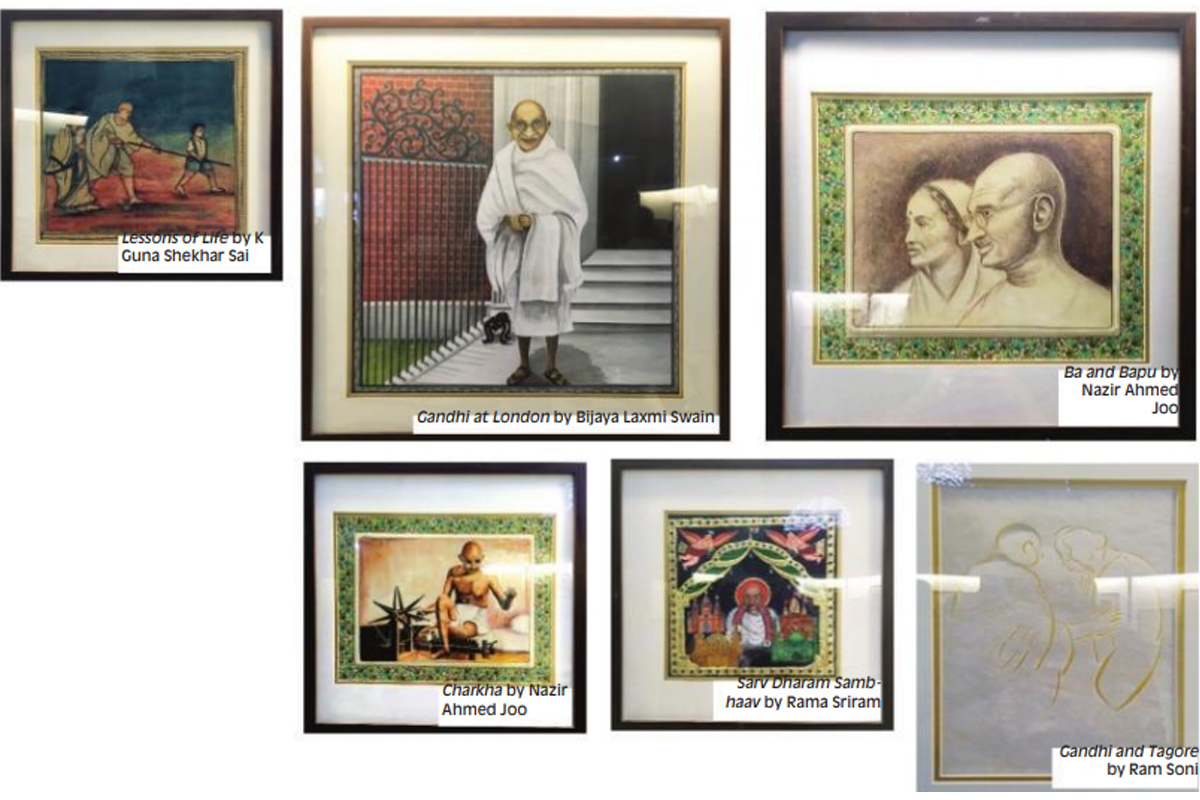We are on the verge of Mahatma Gandhi’s 150th birth anniversary. This day is momentous to say the least, as it is the celebration of the life of not just the man Gandhi was, but also his ideals and principles which can act as a saving grace in today’s highly polarised world.
When one thinks of Gandhi, they think of three primary pillars that he represented — truth, non-violence and simple living. These pillars, though they may seem uncomplicated in their composition, were complex constructs which emanated from the mind of a highly learned man. In fact, he was perhaps the first in a long line of freedom fighters with whom Indians, from poor villagers to affluent businessmen, could relate the most.
Advertisement
Gandhi’s life and the lessons he left us with have been portrayed by artists as a part of an art exhibition, which was organised by Exim Bank and has been put up at the Victoria Memorial Hall, Kolkata. The exhibition, titled “Relive the ideas of the Mahatma through Art”, is open to the public till 10 August. The purpose of the exhibition is to educate audiences about the legacy of the Mahatma through traditional art forms, such as sanjhi craft, tanjore and kalamkari painting.
The first painting, titled Gandhi in South Africa by Mamani Chitrakar from West Bengal, depicts Gandhi’s humiliating experience while he was on his way to Pretoria to fight a case. His abject humiliation came at the hands of a fellow-passenger in a train who objected to the presence of a non-white in a first-class compartment. Gandhi, who had a firstclass ticket, was thrown out with his luggage at Pietermaritzburg station. This was perhaps the first racial offence committed against Gandhi in South Africa. This experience gave him the impetus to fortify the Indian community in the British dominion and demand for egalitarian rights.
Indians in South Africa were not permitted to walk on public footpaths, or to go out of their houses after 9:00 pm without a permit.
They could only do menial jobs and had to pay a poll tax of three pounds to enter places which offered free entry to whites. Such racial subjugation convinced him to start his satyagraha struggle in South Africa. In 1914, when Gandhi departed for India after 21 years of staying in South Africa, several laws discriminating against Indians had been repealed.
A painting by Nazir Ahmed Joo, from Jammu and Kashmir, depicts Gandhi spinning a charkhato make Khadi. This painting symbolically and categorically represents the ideals of Gandhi. He wanted purna swaraj, or complete independence for India; not mere dominion status. He believed that the pre-condition for achieving this feat was to gain self-reliance, which could be achieved through the spinning of Khadi. Khadi represented not just a fabric, but the means to uphold the economic, social and political dignity of the poor. The charkha represented not just a fabric-makingwheel, but the wheel of India’s growth itself.
The same artist created another painting depicting Gandhi and his wife Kasturba. In one of his works, Gandhi says, “It was Ba’s (Kasturba’s) inspiration which helped me reach the heights of my inner self. She was my priceless jewel.” Gandhi considered Ba his closest friend and most loyal ally. The painting, Ba and Bapu, depicts their unbreakable bond; a bond which deepened over the years. Kasturba was devoted to her husband’s mission and was imprisoned several times as a result. Whenever they were apart, they would write letters to each other, simple letters in which they would inquire about each other’s health, how they were spending time in the jail cells, and about how much they longed to see each other.
Gandhi and Tagore is a painting by Ram Soni, from Rajasthan, in which mutual respect and admiration between these two towering Indian personalities is highlighted. The poet and the Mahatma wrote letters to each other quite often; some of praise, some of protest and some of mutual worry for the future of India. Gandhi looked to Tagore as a spiritual guide and Tagore to Gandhi as India’s sole hope for a sound political future. Tagore was the first who hailed Gandhi as “Mahatma” publicly (Privately, Pranjivan Mehta, a businessman and Gandhi’s friend, was the first to address him as “Mahatma”).
The next painting is that of Gandhi as a teacher, philosopher and a guide. Titled Lessons of life and painted by K Guna Shekhar Sai from Andhra Pradesh, it depicts Gandhi’s teachings towards children, whom he loved dearly and housed in his ashrams. There, they were taught the means of simple living, equality (all castes were welcome there) and honest work. Everybody in Gandhi’s ashrams, including his South African settlements, Phenoix and Tolstoy Farm, had to undertake different tasks, including cleaning latrines: a task which was only forced upon the backward classes in those days. Everybody had to undertake all jobs, irrespective of class and caste, including Gandhi himself and Kasturba as well.
Sarv Dharam Sambhaav by Rama Sriram, from Tamil Nadu, depicts Gandhi as the symbol of secularism and syncretism, two principles upon which the foundations of Independent India were built. Gandhi believed in religious freedom and the equality of all religions. In fact, he would ensure that verses from the Koran and the Bible were also recited in his ashrams, along with the Bhagawad Gita. CF Andrews, a British priest was one of his closest friends, whom he would often request to indulge in Christian hymns, and Maulana Azad, a Muslim scholar and educationist, was one of his closest political compatriots. The purpose of religion, according to Gandhi, was to bind man to God, and to his fellow brother. When Gandhi represented India at the Round Table Conference in England in 1931, the global press, fellow delegates and the British public were astounded to see Gandhi wearing a khadi dhotibefore meeting the King of England. Other delegates were dressed in typical western attire. The simplicity of his clothes and the humility in his words represented the true nature of India and Indians, which is depicted through the painting Gandhi in London by Bijaya Laxmi Swain from Odisha. His humble attire served as a stark contrast to the pomp of England’s Buckingham Palace. Perhaps, no man or woman in history has ever been so true to their roots.
Indians could relate to Gandhi because he spoke beyond the intellectual discourse that previous leaders had engaged in among affluent Congress circles. These ideologybased conversations were incomprehensible by, and of little significance to, the largely uneducated Indian masses. Gandhi, on the other hand, spoke of the woes of common Indian men and women. He understood their pain, made it his own and hence, ruled the hearts of the nation. Gandhi believed in the use of “truth-force” to drive the British out of India. But, even more important to him than that was his endeavour to bridge the gaps between Hindus and Muslims in India. He believed that unity between the two communities was sine qua non for the ascendance of India. For that purpose, he was willing to give his life, and he did.
It is hard to imagine what Gandhi would have thought about this art exhibition if he were alive today; he would probably despise it as he despised all the acclaim and recognition that came his away, including the title of “Mahatma”. However, he would probably let slip a subtle smile at the syncretic confluence that the exhibition represents, as the artists come from all four corners of India: North (Jammu and Kashmir), East (West Bengal and Odisha), West (Rajasthan) and South (Andhra Pradesh and Tamil Nadu).
In a sense, the exhibition is ironic. Gandhi’s life and his struggle against the British being honoured in a landmark of British imperialism: poetic justice could not have been delivered more effectively than this.











